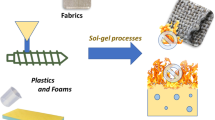Abstract
The frequent occurrence of building fires has triggered a compelling need for flame-retardant coatings. However, the existing flame-retardant coating technologies are high-cost, inefficient, and environmentally unfriendly. In this work, a silica-alumina sol has been developed as the substrate of the flame-retardant coatings. Boron nitride (h-BN) and glass powders with low melting temperature are employed as fillers to improve the flame retardancy. This kind of hybrid coatings can form a high-viscosity liquid-solid phase and be re-paired in high-temperature environments. The experimental results indicate that the as-prepared hybrid coating can act as an oxygen barrier to protect the substrates against fire. Besides, a carbonous layer has been formed on the coating surfaces when exposed to flames, which can stem the spread of the flame spread. Due to the low cost, high stability, self-repairing and easy preparation, the self-repairing hybrid coatings show great potential for application in the fields of fire-proof and flame retarding.
Graphical Abstract

Highlights
-
A silica-alumina sol is developed as the substrate of the flame-retardant coatings.
-
Glass powders with low melting temperature are employed as fillers.
-
The coating can form a high-viscosity liquid-solid phase at high temperatures.
-
The coating can act as an oxygen barrier to protect the substrates against fire.







Similar content being viewed by others
Data availability
The data that support the findings of this research are available from the corresponding author upon reasonable request.
References
Jiang Y, Li F, Mei Y, Ding Y, Zhang P (2021) Gel polymer electrolyte based on hydrophilic–lipophilic TiO2-modified thermoplastic polyurethane for high-performance Li-ion batteries. J Mater Sci 56(3):1–12
Xiao C, Tang X, Peng J, Ding Y (2021) Graphene-like BSi as a promising anode material for Li- and Mg-ion batteries: a first principle study. Appl Surf Sci 563:150278
Khoukhi M (2018) The combined effect of heat and moisture transfer dependent thermal conductivity of polystyrene insulation material: impact on building energy performance. Energy Build 169:228–235
Aytan E, Aytan TA, Kahraman MV (2021) Phosphorus ester containing mesoporous silica as novel high‐effective flame retardant in polyurethane and polyester coatings. ChemistrySelect 6(25):6541–6547. https://doi.org/10.1002/slct.202100708
Wi S, Park JH, Kim YU, Kim S (2021) Evaluation of environmental impact on the formaldehyde emission and flame-retardant performance of thermal insulation materials. J Hazard Mater 402:123463
Cui Y, Liu X, Tian Y, Ding N, Wang Z (2012) Controllable synthesis of three kinds of zinc borates and flame retardant properties in polyurethane foam. Colloids Surf A: Physicochem Eng Asp 414:274–280. https://doi.org/10.1016/j.colsurfa.2012.08.028
Qin X, Zhu S, Chen S, Deng K (2013) The mechanism of flame and smoke retardancy of asphalt mortar containing composite flame retardant material. Constr Build Mater 41:852–856
Fang Y, Cui P, Ding Z, Zhu J-X (2018) Properties of a magnesium phosphate cement-based fire-retardant coating containing glass fiber or glass fiber powder. Constr Build Mater 162:553–560. https://doi.org/10.1016/j.conbuildmat.2017.12.059
Liu H, Yang H, Chen M, Jiang Y, Wan C (2018) An effective approach to reducing fire hazards of rigid polyurethane foam: fire protective coating. J Coat Technol Res 16(1):257–261. https://doi.org/10.1007/s11998-018-0149-1
Chen HB, Shen P, Chen MJ, Zhao HB, Schiraldi DA (2016) Highly efficient flame retardant polyurethane foam with alginate/clay aerogel coating. ACS Appl Mater Interfaces 8(47):32557–32564. https://doi.org/10.1021/acsami.6b11659
Li P, Liu C, Jiang Q, Tao Y, Xu Y, Liu Y, Zhu P (2022) Halogen‐free coatings combined with the synergistic effect of phytic acid and montmorillonite for fire safety flexible polyurethane foam. Macromol Mater Eng 307:2100930
Zeng H, Wang L, Zhang D, Wang F, Sharma VK, Wang C (2019) Amido-functionalized carboxymethyl chitosan/montmorillonite composite for highly efficient and cost-effective mercury removal from aqueous solution. J Colloid Interface Sci 554:479–487
Huang Y, Feng Q, Ye C, Nair SS, Yan N (2020) Incorporation of ligno-cellulose nanofibrils and bark extractives in water-based coatings for improved wood protection. Prog Org Coat 138:105210
Sun F-C, Fu J-H, Peng Y-X, Jiao X-M, Liu H, Du F-P, Zhang Y-F (2021) Dual-functional intumescent fire-retardant/self-healing water-based plywood coatings. Prog Org Coat 154:106187
Zhang T, Xi J, Qiu S, Zhang B, Luo Z, Xing W, Song L, Hu Y (2021) Facilely produced highly adhered, low thermal conductivity and non-combustible coatings for fire safety. J Colloid Interface Sci 604:378–389
Muñoz JF, Yao Y, Youtcheff J, Arnold T (2014) Mixtures of silicon and aluminum oxides to optimize the performance of nanoporous thin films in concrete. Cem Concr Compos 48:140–149. https://doi.org/10.1016/j.cemconcomp.2013.11.013
Kumar A, Malik G, Pandey MK, Chandra R, Mulik RS (2021) Corrosion behavior of pulse laser deposited 2D nanostructured coating prepared by self-made h-BN target in salinity environment. Ceram Int 47(9):12537–12546
Gautam C, Gautam A, Mishra VK, Ahmad N, Trivedi R, Biradar S (2019) 3D interconnected architecture of h-BN reinforced ZrO2 composites: structural evolution and enhanced mechanical properties for bone implant applications. Ceram Int 45(1):1037–1048
Jiang Y, Zhang P, Jin H, Liu X, Ding Y (2019) Flexible, nonflammable and Li-dendrite resistant Na2Ti3O7 nanobelt-based separators for advanced Li storage. J Membr Sci 583:190–199. https://doi.org/10.1016/j.memsci.2019.04.032
Ding Y, Liu T, Jiang Y, Zhou J, Zhou Z, Sun J, Peng J (2022) Flexible fire-resistant and heat-insulating materials fabricated using sodium titanate nanobelts. Mater Today Nano 17:100161. https://doi.org/10.1016/j.mtnano.2021.100161
Acknowledgements
This work was financially supported by Scientific Research Foundation of Hunan Provincial Education Department (22A0113).
Author information
Authors and Affiliations
Contributions
ZC and PY: methodology, investigation, writing—original draft; YD: writing—review and editing, project administration.
Corresponding author
Ethics declarations
Conflict of interest
The authors declare no competing interests.
Additional information
Publisher’s note Springer Nature remains neutral with regard to jurisdictional claims in published maps and institutional affiliations.
Supplementary information
Rights and permissions
Springer Nature or its licensor (e.g. a society or other partner) holds exclusive rights to this article under a publishing agreement with the author(s) or other rightsholder(s); author self-archiving of the accepted manuscript version of this article is solely governed by the terms of such publishing agreement and applicable law.
About this article
Cite this article
Ding, Y., Chen, Z. & Yin, P. Self-repairing non-expanded flame-retardant coatings prepared by sol-gel method. J Sol-Gel Sci Technol 106, 545–552 (2023). https://doi.org/10.1007/s10971-023-06077-y
Received:
Accepted:
Published:
Issue Date:
DOI: https://doi.org/10.1007/s10971-023-06077-y




